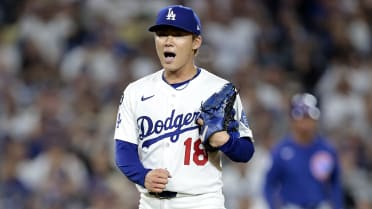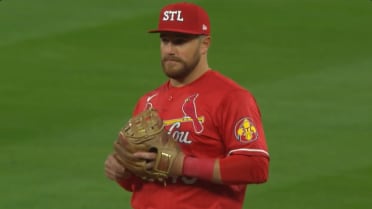The Mets are now just four wins from the World Series, as they await their National League Championship Series opponent. Regardless of whether it’s the Dodgers or Padres, though, it’s clear that New York will need its stars to continue rising to the moment.
In the Division Series against the NL East champion Phillies, Pete Alonso, Brandon Nimmo and Mark Vientos raked. Sean Manaea, Luis Severino and Jose Quintana delivered big-time starts. And Francisco Lindor came through with one of the biggest swings in Mets history.
It’s easy to say that the Mets will need all of those guys again if they are going to continue their astonishing run to the Fall Classic. But they will need more than that, too. Here are five other players who will be NLCS X-factors for the Mets.
1) Kodai Senga
Senga's return to start Game 1 of the NLDS was an emotional boost for the Mets -- and Mets fans, who thought they might've lost their ace for the entire postseason. But how much can Senga actually give the Mets in the NLCS?
Senga pitched only two innings against the Phillies -- it was his first start since July 26, after all, which itself was his only start of the regular season. And even though Senga settled down and looked sharp after Kyle Schwarber's leadoff home run -- that was the only hit he allowed, and he struck out three -- he's obviously not all the way back just yet.
The ghost fork is still as nasty as ever, but Senga still has to build up some velocity (his fastball did touch 97 mph, but it averaged 94.3 mph, compared to the 95.7 mph it averaged in 2023 and the 95.6 mph it averaged in his lone regular season start of 2024), and more importantly, length.
Whether the Mets face the Dodgers or Padres, they'll be facing one of the deepest, most dangerous lineups in the league. They'll need their ace. Senga is a Cy Young-caliber pitcher at his best. But will he be at his best? How deep into the game can Senga go against the Dodgers or Padres? Can he give the Mets three, four, five innings? Can he make multiple starts in a best-of-seven series? The more outs Senga can get, the better chance the Mets have to win this series.
2) Edwin Díaz
Does Díaz have his mojo back?
It is by far the most important question facing the Mets' bullpen entering the NLCS. Díaz has been a rollercoaster over the last couple of weeks -- from his blown save in Atlanta at the end of the regular season, to another blown save against the Phillies in Game 2 of the NLDS, right up until he walked the first two batters he faced in the ninth inning of NLDS Game 4 at Citi Field.
But that's when some inspiration from Francisco Lindor during a mound visit might have flipped the switch and turned Díaz back into his unhittable self. The Mets closer was reportedly trying to hype himself up by saying, "Let's go, let's go," only for Lindor to tell Díaz, "Don't say 'Let's go.' Just do it."
Díaz responded with his most overpowering sequence of the playoffs -- striking out Kody Clemens on a 98.7 mph fastball, getting Brandon Marsh to fly out on a 99.2 mph fastball and finally blowing away Kyle Schwarber at 101.1 mph, his fastest pitch of the season, to send the Mets to the NLCS. Díaz's celebration on the mound looked like the old, confident Edwin Díaz.
If that's the Díaz the Mets get against the Dodgers or Padres, New York has one of the most dominant closers in the game, someone who can be called on for showdowns with Shohei Ohtani and Mookie Betts or Fernando Tatis Jr. and Manny Machado in the highest-pressure situations. If the Mets get shaky Edwin Díaz, the Díaz who can't command his fastball or put away hitters with the game on the line, how will they handle the superstar hitters of Los Angeles or San Diego?
3) Jeff McNeil
McNeil hasn’t played for the Mets in more than a month, since sustaining a right wrist fracture when he was hit by a pitch on a bunt attempt. The injury interrupted a resurgence for the 32-year-old, who hit only .216 with a .591 OPS before the All-Star break but .289 with a .923 OPS after it, homering seven times in 41 games, thanks in part to some adjustments at the plate.
But the Mets extending their season has opened the door for McNeil’s return. In fact, manager Carlos Mendoza said after the conclusion of the NLDS that “there’s a really good chance” the veteran second baseman makes the team’s NLCS roster. First, McNeil will play two rehab games in the Arizona Fall League to get ready.
Assuming McNeil is in fact on the roster -- and isn’t too rusty -- he is potentially a huge addition for the Mets, even as a weapon off the bench. McNeil has fared well as a pinch-hitter in his career (.273/.360/.432 in 50 regular season plate appearances) and could step in for a right-handed batter such as Jose Iglesias or Tyrone Taylor in a key situation against a tough right-handed pitcher. But if McNeil can start -- perhaps at second for Iglesias, who has a .440 OPS this postseason -- he could lengthen the Mets' lineup.
4) Jesse Winker
Winker has already provided a few big moments in these playoffs: his two-run triple off Freddy Peralta in Game 1 of the Wild Card Series, the insurance run he scored in the ninth inning of the Mets' comeback win in the winner-take-all Game 3 over the Brewers, the moonshot home run he crushed off Aaron Nola into the upper deck at Citi Field in the NLDS.
Now, the Mets will likely be turning to Winker for even more. The lefty slugger, who's been DHing against right-handed opposing starters, will likely get lots of at-bats in the NLCS. That's because the pitching staffs of both the Dodgers and the Padres are largely right-handed, and in particular the rotations. Dodgers starters Yoshinobu Yamamoto, Jack Flaherty, Walker Buehler and Landon Knack are all righties, as are Padres starters Dylan Cease, Yu Darvish and Michael King.
And even if Winker comes off the bench for any of the NLCS games, he could be called upon in a big spot -- against Dodgers high-leverage relievers Michael Kopech, Blake Treinen and Evan Phillips, for example, or Padres flamethrowing closer Robert Suárez.
Winker can mash righties -- he hit 13 of his 14 home runs this season against them (plus his playoff homer off Nola), and had a 123 OPS+ against right-handers. He should have plenty of opportunities to impact the NLCS because of that.
Coming off a rough 2023, the 29-year-old left-hander enjoyed a terrific season for the Mets. Although he didn’t debut until May 29 after rehabbing from offseason hip surgery, Peterson wound up starting 21 games and posting a 2.90 ERA, while the Mets went 15-6 in his outings. (While he was far from the only reason, New York went 22-32 before he joined the rotation and 67-41 afterward.)
Peterson’s success has continued this postseason -- just not as a starter. He saved the decisive Game 3 of the Wild Card Series against the Brewers, piggybacked with Senga to deliver three scoreless innings in Game 1 of the NLDS against the Phillies, then tossed another 2 1/3 scoreless innings in the Game 4 clinch. In that appearance, Peterson entered with two on, two out and the Mets down a run in the sixth and retired Bryson Stott to escape trouble. Later, he set down Kyle Schwarber, Trea Turner and Bryce Harper while earning the win.
The point here is: The Mets absolutely will count on Peterson in the NLCS. The only question is in what role(s). Given the needs of a seven-game series, he could get a start, but he also might be more valuable out of the ‘pen, whether it’s backing up Senga or squaring off with a dangerous lefty like Shohei Ohtani or Jackson Merrill in a crucial spot.
David Adler is a reporter for MLB.com based in New York.
Andrew Simon is an editor and writer for MLB.com.




